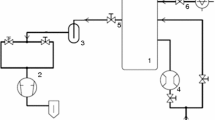Abstract
Carbon dioxide (CO2) emission reduction is critical to mitigating climate change. Power plants for heating and industry are significant sources of CO2 emissions. There is a need for identifying and developing new, efficient methods to reduce CO2 emissions. One of the methods used is flue gas purification by CO2 capture through adsorption. This study aimed to develop CO2 adsorbent out of modified brown coal impregnated with solutions of first-, second-, and third-order amines. Low-temperature nitrogen adsorption isotherms and CO2 isotherms were measured for the prepared samples. The results of experiments unexpectedly revealed that CO2 sorption capacity decreased after impregnation. Due to lack of strait trends in CO2 sorption capacity decrease, the results were closely analyzed to find the reason for the inconsistencies. It was revealed that different amines represent different affinities for CO2 and that the size and structure of impregnating factor has influence on the CO2 sorption capacity of impregnated material. The character of a support was also noticeable as well for impregnation results as for the affinity to CO2. The influence of amine concentration used was investigated along with the comparison on how the theoretical percentage of the impregnation on the support influenced the results. The reaction mechanism of tertiary amine was taken into consideration in connection to no presence of water vapor during the experiments. Key findings were described in the work and provide a strong basis for further studies on CO2 adsorption on amine-impregnated support.












Similar content being viewed by others
References
Baran, P., Zarębska, K., & Czuma, N. (2015). Wykorzystanie modyfikowanego węgla brunatnego do adsorpcji ditlenku węgla (Use of modified lignite for the adsorption of carbon dioxide). Przemysl Chemiczny, 94(2), 221–224.
Buczek, B. (2012). Properties of active carbon with various particle shapes obtained in char-steam reaction. Chemical and Process Engineering, 33(3), 335–344.
CO2 Capture Technologies Post Combustion Capture (PCC). January 2012, Global CCS Institute
Consonni, S., Vigano, F., Kreutz, T., De Lorenzo, L. (2007). Sixth Annual Conference On Carbon Capture & Sequestration Capture—Advanced Concepts CO2 Capture In IGCC Plants via Cryogenic Separation
Deng, S., Hu, B., Chen, T., Wang, B., Huang, J., Wang, Y., et al. (2015). Activated carbons prepared from peanut shell and sunflower seed shell for high CO2 adsorption. Adsorption, 21, 125–133.
Goertzen, S. L., Thériault, K. D., Oickle, A. M., Tarasuk, A. C., & Andreas, H. A. (2010). Standardization of the Boehm titration. Part I. CO2 expulsion and endpoint determination. Carbon, 48, 1252–1261.
Gray, M. L., Soong, Y., Champagne, K. J., Baltrus, J., Stevens Jr., R. W., Toochinda, P., et al. (2004). CO2 capture by amine-enriched fly ash carbon sorbents. Separation and Purification Technology, 35, 31–36.
Ko, Y. G., Shin, S. S., & Choi, U. S. (2011). Primary, secondary, and tertiary amines for CO2 capture: designing for mesoporous CO2 adsorbents. Journal of Colloid and Interface Science, 361(2), 594–602.
Lee, C. S., Ong, Y. L., Aroua, M. K., & Daud, W. M. A. W. (2013). Impregnation of palm shell-based activated carbon with sterically hindered amines for CO2 adsorption. Chemical Engineering Journal, 219, 558–564.
Liu, S.-H., Lin, Y.-C., Chien, Y.-C., & Hyu, H.-R. (2011). Adsorption of CO2 from flue gas streams by a highly efficient and stable aminosilica adsorbent. Journal of the Air & Waste Management Association, 61, 226.
Majchrzak-Kucęba, I., Nowak, W. (2008). Synthesis of polymer—modified mesoporous materials for the adsorption of carbon dioxide. Proceedings of the 21st International Conference on Efficiency, Cost, Optimization, Simulation and Environmental Impact of Energy Systems. Cracow-Gliwice, Poland. Energy Systems, ECOS 2008, 1467–1473.
Maroto-Valer, M. M., Tang, Z., & Zhang, Y. (2005). CO2 capture by activated and impregnated anthracites. Fuel Processing Technology, 86, 1487–1502.
Maroto-Valer, M. M., Lu, Z., Zhang, Y., & Tang, Z. (2008). Sorbents for CO2 capture from high carbon fly ashes. Waste Management, 28, 2320–2328.
Metz, B., & Davidson, O. (2005). Carbon dioxide capture and storage. IPCC special report. New York: Cambridge University Press.
Nguyen, C., & Do, D. D. (2001). The Dubinin–Radushkevich equation and the underlying microscopic adsorption description. Carbon, 39, 1327–1336.
Plaza, M. G., Pevida, C., Arenillas, A., Rubiera, F., & Pis, J. J. (2007). CO2 capture by adsorption with nitrogen enriched carbons. Fuel, 86, 2204–2212.
Shao, R., Stangeland, A. (2009). Amines used in CO2 capture-health and environmental impacts, The Bellona Foundation Bellona Report
Wang, J., Chen, H., Zhou, H., Liu, X., Qiao, W., Long, D., et al. (2013). Carbon dioxide capture using polyethylenimine-loaded mesoporous carbons. Journal of Environmental Sciences, 25(1), 124–132.
Webley, P. A. (2014). Adsorption technology for CO2 separation and capture: a perspective. Adsorption, 20, 225–231.
Wilk, A., Więcław-Solny, L., Krótki, A., & Śpiewak, D. (2013). Impact of the composition of absorption blend on the efficiency of CO2 removal. Chemik, 67(5), 399–406.
Yu, C.-H., Huang, C.-H., & Tan, C.-S. (2012). A review of CO2 capture by absorption and adsorption. Aerosol and Air Quality Research, 12, 745–769.
Acknowledgments
The authors are grateful to the AGH University of Science and Technology (Project 11.11.210.244) for its financial support of this work.
Author information
Authors and Affiliations
Corresponding author
Ethics declarations
Conflict of interest
The authors declare that they have no conflict of interest.
Rights and permissions
About this article
Cite this article
Baran, P., Zarębska, K. & Czuma, N. CO2 adsorption properties of char produced from brown coal impregnated with alcohol amine solutions. Environ Monit Assess 188, 416 (2016). https://doi.org/10.1007/s10661-016-5423-z
Received:
Accepted:
Published:
DOI: https://doi.org/10.1007/s10661-016-5423-z




